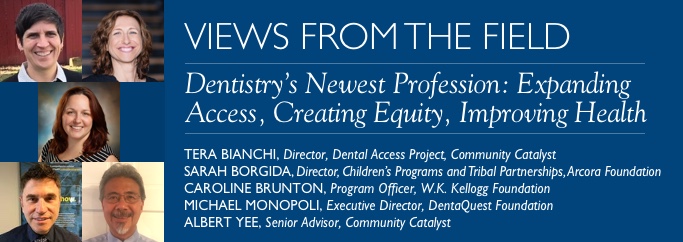
Dental therapists are oral health care’s newest professionals. In the same way that physician assistants work with medical teams, dental therapists are supervised by dentists and expand the reach of the dental team, which allows people to get dental care in communities that have long gone without it.
This expansion of dental care’s reach is essential, because nearly one-third of people in the United States do not have access to dental care. As a result, they face a myriad of health, social and economic challenges. The problem is substantially more acute for people in rural areas, lower-income people, people of color, senior citizens and people with disabilities, and is likely to be exacerbated by the current administration’s health policies.
Philanthropy has played a significant role in helping dental therapy spread, with impressive results. In a little over a decade, dental therapy traveled from tribal communities in Alaska to dental teams in Minnesota, Oregon, and Washington. Arizona, Maine, and Vermont have all passed legislation allowing dental therapists to practice and more than a dozen jurisdictions are pursuing dental therapy for their communities.
This growth has been guided by research demonstrating that dental therapy has clear, positive impacts on people who for years had inadequate access to care and suffered from poor oral health. A recent study of Alaska’s dental therapy program, the longest-running one in the country, shows that long-term oral health outcomes improve in communities with dental therapists (Chi et al. 2018). Having a dental therapist present also results in fewer pulled teeth and invasive procedures among children. Program evaluations repeatedly showed that dental therapy improves access to care and prevention services for historically underserved populations, and patients are highly satisfied with their care (Wetterhall et al. 2010).
Dental therapy also has substantial economic upsides. Analyses of nonprofit clinics, as well as private dental offices employing dental therapists, have found having a dental therapist on staff increases revenue and allows more patients to be seen—including Medicaid patients who often struggle to find a dentist willing to take their insurance (Kim 2013). In some cases, after hiring a dental therapist, dental offices have seen so much growth they have had to hire additional dentists, dental hygienists, and administrative staff.
This success reflects how philanthropy can support and complement the vision and efforts of local champions, strong advocates, and enlightened policymakers. From the early days of dental therapy, philanthropy saw its promise as a community-led innovation with the potential to shake up our fragmented oral health delivery system, promote health equity, expand care to millions of people and improve health. In addition, dental therapy’s accessible and efficient educational programs, which are reflected in the Council on Dental Accreditation’s standards for dental therapy education, offer the opportunity for homegrown jobs in underserved communities that could break down barriers to culturally competent oral health care while strengthening local economies.
Funders acted by supporting research and evaluation efforts to learn and identify best practices of dental therapy programs and sharing this knowledge broadly through publications, convenings, and dialogue. This evidence-based information addressed early misconceptions that some people had about dental therapy and paved the way for better understanding and acceptance of the profession, and of the incorporation of dental therapists into dental teams. Funders also supported advocacy and communication efforts along with the development and implementation of educational programs and pilot and start-up clinical programs. The result is a safe, effective provider that meets community needs.
As interest in dental therapy grows and successes mount, philanthropy remains a strong and influential partner. New funders, even some not traditionally engaged in oral health, are showing interest in dental therapy because of its potential to improve oral health; address social justice and health equity issues; and increase access to innovative, effective postsecondary education models, jobs, and economic development in their communities.
This is a good time for funders to get involved as the funding opportunities and strategies for this work are both numerous and urgent. Support is needed to assure the sustainability and scalability of dental therapy programs, to help advocates overcome opposition from organized dentistry similar to the resistance to dental hygienists decades ago, and to help create political will.
To that end, several funders who are part of the Funders Oral Health Policy Group, a national learning community of funders focused on oral health policy, see value in creating a funder’s affinity group for dental therapy. This Dental Therapy Funders Table would promote information sharing and peer learning, coordination of activities, resources and advocacy, and identify opportunities for collective action.
The funders leading this effort are all committed to community engagement in their philanthropic work, view improving oral health as a social justice and health equity opportunity, and see dental therapy as a promising approach aligned with these principles.
As a new entity, the Dental Therapy Funders Table is determining how best to support members in learning about and collaborating and capitalizing on the well-documented benefits of dental therapy for their communities.
The authors welcome inquiries, ideas and suggestions for the Dental Therapy Funders Table and look forward to working with peer organizations to grow this young profession, which holds such promise for addressing one of health care’s most intractable challenges.
To learn more about the Dental Therapy Funders Table contact Albert K. Yee, MD, MPH, Senior Advisor, Community Catalyst (ayee@communitycatalyst.org).
References
Chi, Donald L., Dane Lenaker, Lloyd Mancl, Matthew Dunbar, and Michael Babb. “Dental Therapists Linked to Improved Dental Outcomes for Alaska Native Communities in the Yukon-Kuskokwim Delta.” Journal of Public Health Dentistry 78, no. 2 (March 2018): 175-82. Accessed August 23, 2018.
Scott Wetterhall, James D. Bader, Barri B. Burrus, Jessica Y. Lee, and Daniel A. Shugars. Evaluation of the Dental Health Aide Therapist Workforce Model in Alaska: Final Report. RTI International. October 2010. Accessed August 23, 2018.
Minnesota Department of Health and Minnesota Board of Dentistry. Early Impacts of Dental Therapists in Minnesota. February 2014. Accessed August 23, 2018.
Kim, Francis M. Economic Viability of Dental Therapists. Report. May 2013. Accessed August 23, 2018.
Apple Tree Dental. An Advanced Dental Therapist in Long-Term Care: Heather Luebben’s Case Study. Report. February 20, 2018. Accessed August 23, 2018.
Apple Tree Dental. An Advanced Dental Therapist in Rural Minnesota: Jodi Hager’s Case Study. Report. February 21, 2018. Accessed August 23, 2018. Diaz, Jose, Brittney Wagner, and Melanie Ferris.
Midwest Dental: Dental Therapist Case Study and Addendum: Dental Therapist Production and Revenues. Report. Wilder Research. May 2017. Accessed August 23, 2018.
Diaz, Jose, Brittney Wagner, and Melanie Ferris. Grand Marais Family Dentistry: Dental Therapist Case Study and Addendum: Dental Therapist Production and Revenues. Report. Wilder Research. May 2017. Accessed August 23, 2018.
The Pew Charitable Trusts. Expanding the Dental Team: Increasing Access to Care in Public Settings. Report. June 2014. Accessed August 23, 2018.
The Pew Charitable Trusts. Expanding the Dental Team: Studies of Two Private Practices. Report. February 2014. Accessed August 23, 2018.

